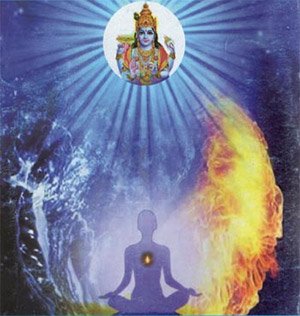Siddhanta Sangraha of Sri Sailacharya
by E. Sowmya Narayanan | 2008 | 30,562 words
Siddhanta Sangraha Chapter 33 (English translation), entitled “potency” as included in the critical edition and study. The Siddhanta Samgraha is a Sanskrit philosophical text dealing with Vishishtadvaita in five hundred Sanskrit verses. It was written by Shri Shailacarya (18th century) and closely follows the philosophy of Vedanta Deshika (13th century).
Chapter 33 - Potency
349. Śakti is classified as yoga (etymology) and rūḍī (conventional). Yoga śakti is possible by vyākaraṇa, śrauta and nirukta.
350. It has been stated earlier that the rūḍīśakti is possible
by the advice of the elders. (The word ‘cow’ is connotative of the form or the configuration of a cow and gets culminated in the object that possesses the universal jāti of cow).
351. According to vaidikas, all the words express the inseparable attributes. Of them, except the words that convey jāti and śarīra, the other words convey the individual that possesses those attributes.
352. Therefore, the words that denote the objects that is constituted of sentient and in-sentient entities ultimately convey the Supreme, the inner-self of all these entities. But for those who are ignorant of this truth, think that the word convey only that particular object or entity.[1]
353. After the study of Vedānta one attains the complete knowledge that the words conveying the ‘body’ ultimately convey the 'inner-self' namely, the Paramatman of that body. In the same way the words that are used in the world only denote the ‘inner self’ or the Supreme Lord.
354. (If it is doubted that how the above view is accepted? then;) The words through the power of different connotations (pravṛtti nimitta) convey through that form of an individual self and the Supreme Self because of their inseparable relation.[2]
355. On the validity of the scriptural statements such as ‘ahaṃ vaiśvānaro bhūtvā’ and ‘somo bhūtvā’ express the existence (sattā) of the inner-self in all the entities.
356. In practical usage, it is observed that the elders teach words such as mother, father, uncle and already existing people to the children, in order to make them understand the recollective potency of words. Then, they gradually teach the small sentences.
357. Here, the potency of the word is understood in the accomplished elements without an activity. The potency of the word is that ‘the word which has the capacity to convey the particular meaning’. This happens in accomplished elements also. Even the sentences also convey the same.
358. Thus, the elders by using the word in the existing elements make us to understand the potency of the word (śaktigraha). This is a universally accepted truth. Therefore, the assumption of the ignorant persons is that all the words are related to an activity and not denoting the accomplished elements, is not correct. The words may be either related to an activity or to an accomplished element.[3]
359. (According to the mīmāṃsakas though the words such as ambā, tāta, mātula have the potency to convey the sense, as they are not included in the injunctive statements, loses their potency of being an accomplished element. Therefore, the statements of the Upaniṣad are useless as they are not injunctive in nature. Then; As Brahman is self-explanatory, it is applicable or useful for men, though not having any injunctive statements as found in the statement ‘there is treasure in your house’. In the above statement a person witnesses the 'treasure' though there is no injunction in it. Similarly, the accomplished sentences are having the 'capability of delivering the truth', they are valid.[4]
360. When the primary sense does not fit in, the knowledge of the word or sentence (śābda), the knowledge of expectation (ākāṅkṣa) and the collective meaning (tātparyārtha) are the causes for understanding the knowledge of the word śābda bodha. The collective meaning should be accepted when there is the existence of many meanings.
361. It cannot be accepted that there is no śābda jñāna when there is a contradiction of the primary sense. Because in the illusion of the body itself as the self. We accept the truth namely, that the body and the soul are distinct based on the scriptures.
Footnotes and references:
[1]:
See Vedārtha Saṅgraha, pp.39-41
[2]:
Ibid.
[3]:
See Śrī Bhāṣya, I-i-1, Vol-I, pp.88-89.
[4]:
Ibid. p.90.
Conclusion:
 This concludes Potency according to Vishishtadvaita philosophy explained by Shri Shailacarya. This book follows the model of Vedanta Deshika although the Vishishta Advaita school was originally expounded by Shri Ramanuja. Vishishta-Advaita is one of the various sub-schools of Vedanta which itself represents one of the six orthodox schools of Hindu Philosophy. They highlight the importance of the Upanishads, the Bhagavad Gita and the Brahma Sutras.
This concludes Potency according to Vishishtadvaita philosophy explained by Shri Shailacarya. This book follows the model of Vedanta Deshika although the Vishishta Advaita school was originally expounded by Shri Ramanuja. Vishishta-Advaita is one of the various sub-schools of Vedanta which itself represents one of the six orthodox schools of Hindu Philosophy. They highlight the importance of the Upanishads, the Bhagavad Gita and the Brahma Sutras.
